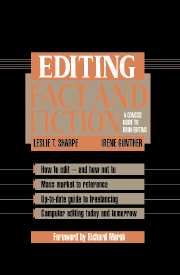Book contents
- Frontmatter
- Contents
- Foreword
- Acknowledgments
- Introduction
- Chapter 1 Who (and What) Is an Editor?
- Chapter 2 Fact or Fiction? Finding Your Niche
- Chapter 3 Principles to Edit By
- Chapter 4 The Editor's Senses
- Chapter 5 The Editor's Sensibility
- Chapter 6 A Guide to Editorial Freelancing
- Chapter 7 Electronic Editing Today and Tomorrow
- Chapter 8 Tools of the Trade and How to Use Them
- Index
Foreword
Published online by Cambridge University Press: 21 September 2009
- Frontmatter
- Contents
- Foreword
- Acknowledgments
- Introduction
- Chapter 1 Who (and What) Is an Editor?
- Chapter 2 Fact or Fiction? Finding Your Niche
- Chapter 3 Principles to Edit By
- Chapter 4 The Editor's Senses
- Chapter 5 The Editor's Sensibility
- Chapter 6 A Guide to Editorial Freelancing
- Chapter 7 Electronic Editing Today and Tomorrow
- Chapter 8 Tools of the Trade and How to Use Them
- Index
Summary
“The General made an audible noise.”
I read this sentence in a bestseller recently, and it made my editor's blood boil. Go try and make an inaudible noise, damn it, I wanted to yell. Where was the editor for this novel? The copyeditor? The proofreader?
You'll read about redundancy in this book, as you'll read about innumerable other sins that authors make and editors should catch. You'll find out, too, about the variety of tasks, despite considerable overlapping, among an acquisitions editor, a managing editor, a copyeditor, and a proofreader. You'll discover the marked differences between an editor for a commercial trade house and one who works on textbooks. You'll get to know the full range of what every editor does, presented with wit, verve, completeness, tact, and passion.
Leslie T. Sharpe and Irene Gunther have written by far the most complete manual for editors ever published, and they've spiced it with dozens of examples, taken from life, that will delight everyone who has had or is about to have a career in publishing.
Yes, the authors have given us each nut and every bolt (“cliché!” screams the editor) of the editorial process. But they've given us something far more valuable. Through all the chapters of this book shines a love of words, of good English, so lacking in publishing today.
For the craft of acquiring good writing is a disappearing one. “Bring us big books,” proclaim the heads of the publishing conglomerates. “Big books by ‘big’ authors.”
- Type
- Chapter
- Information
- Editing Fact and FictionA Concise Guide to Book Editing, pp. vii - xPublisher: Cambridge University PressPrint publication year: 1994



